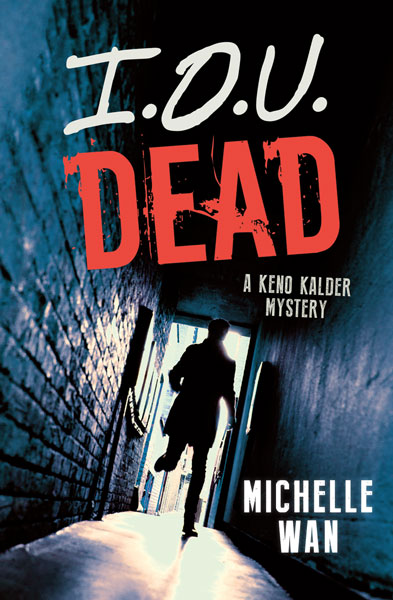| ________________
CM . . .
. Volume XXII Number 32. . . .April 22, 2016
excerpt:
Keno Kalder, the main character and narrator of I.O.U. Dead, finds himself with no good options after he witnesses a well known political figure flee the scene of a murder, and then he walks in on his partner standing over the victim. Keno must decide between two unpleasant choices: telling the police what he knows and possibly becoming a murder suspect himself, or listening to his partner and becoming involved in an attempted extortion. With few friends that he can trust, and very few resources, the narrator must find a way to prove that a rich, well connected socialite is not who he appears to be before he, himself, is arrested and his best and only friend becomes the next victim. I.O.U. Dead is compelling and addictive from the first sentence. The story and the characters are revealed and develop at an excellent pace a difficult task in a novel as short as this one. The story begins in medias res. Keno explains in the first chapter that he is already in trouble and his life is in danger; he tells readers that he’s simply writing this down with the hope that someone will read it and know what has happened. The effect of structuring the story this way is increased suspense. In a typical first person narrative such as this, the reader knows the character survives they have lived to tell the story. I.O.U. Dead removes that security blanket by beginning the story in the middle. Keno, himself, is a likeable character who garners sympathy from the reader in spite of his profession. As the “I.O.U” portion of title of the novel hints at, Keno works as a debt collector and is characterized as something of a “low life”. Readers are told that Keno often feels sorry for the people he collects debts from, that he is often lenient with them, and never uses violence to make people pay up. Readers also learn Keno suffers from ADHD, has trouble reading, and has overcome a severe stutter. Thus, Keno’s backstory and personality make him a sympathetic, engaging, and relatable character. The writing style in the book is, at different times, both a strong point and a weak point. The sentences and vocabulary are simple and easy to understand, a style that can often lead to corny and poorly written prose, but that is not the case here. Michelle Wan’s writing style is clear and effective without being obviously dumbed down to the point of insulting a lower literate reader’s intelligence. Where the style is a little weaker is with the narrator’s voice and the dialogue. Dialect writing is often overdone especially among portrayals of criminality or the darker side of society. And while Wan’s portrayal of two debt collectors sometimes seems genuine, the dialogue sometimes lapses into corniness. For example, the main character is often called “dumbbutt” by his tough as nails partner Jaco. Keno’s response is always: “...don’t call me dumbbutt.” As a teacher of Vocational level students, I can easily picture the mockery of such a term and students ironically calling each other “dumbbutt” for the rest of a semester. In a book that already occasionally uses profanity, I can think of a very simple modification to this term to make it seem more genuine. In spite of this minor weakness, I.O.U. Dead is a strong story with strong characters and an interesting and worthwhile thematic message. The theme is hinted at when Keno shows up to collect a rent from an elderly woman who won’t open the door, fearing that he’s a serial killer known as “The Hammer”. Keno asks: “Do I look like The Hammer?”, to which the woman responds: “No, but how do I know? With all these goings on, how does anyone know?” The author effectively demonstrates that appearances are often deceiving and people are not always who they seem to be, especially in business and politics. Keno and Jaco, who seem to be the down on their luck low lifes, are actually more of the heroic type while the more respectable characters in the book turn out to be not nearly so upright as they appear. I.O.U. Dead is a captivating mystery that, despite some weak dialogue, will easily hold the attention of high school students as well as adults. Highly Recommended. Joe MacLachlan is a high school English teacher in Brampton, ON, who procrastinates endlessly when writing book reviews.
To comment
on this title or this review, send mail to cm@umanitoba.ca.
Copyright © the Manitoba Library Association. Reproduction for personal
use is permitted only if this copyright notice is maintained. Any
other reproduction is prohibited without permission.
Next Review |
Table of Contents for This Issue
- April 22, 2016. |
